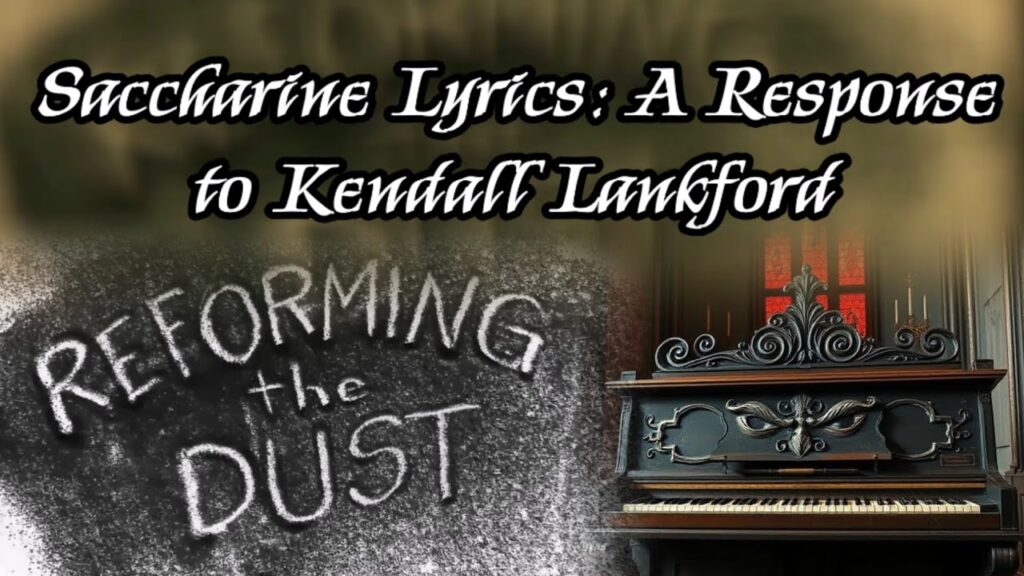For thirty years, Biblical churches have been singing “How Deep the Father’s Love for Us.” But that was before Facebook. According to a recent post, there’s one line in the song that has been flying under our heresy detectors this whole time. The post is written by Kendall Lankford and has been generously reshared with most reactions ranging from challenged to enlightened. At the outset, I would like to go on the record saying that I did my homework on the man and believe him to be a sound pastor. This discourse is not about the author, but about the article.
If my tone is a bit more confrontational than usual, this is because the article is distinctly accusatory. It’s not presented as food for thought, a friendly disagreement, or a warning about potential implications. It throws down the gauntlet on the line in question with scathing claims. If my response squares up to this a bit, I hope it will be taken not as an ad hominem, but as more of an age, vir. “Come on, man.” With that said, let’s look at the first paragraph.
“There are lies that slither into the Church with soft melodies and saccharine lyrics, cloaked in minor chords and tear-jerking crescendos. Few have slithered more subtly or struck more effectively than the now-famous refrain: ‘The Father turned His face away.’ It’s meant to evoke solemnity, to stir our hearts into grieving what we have done to God’s Son. But whatever sentiment it aims to elicit, the phrase itself is heresy.”
I can’t help but smile as I’m reminded so much of myself when I first started writing theological articles. One of the first lessons to be learned is: don’t use your thesaurus more than you use your Bible. As a pianist who’s been playing the tune in question at my church for over a decade, I can confirm there is a well-placed D minor in this lyric, but it’s not a refrain and there is no crescendo. This may seem like nitpicking, but it must be noted that misusing words in a long string of dramatic imagery does more damage to your credibility than you realize. So I regret to inform you that you’re still not Doug Wilson.
More importantly, “few have slithered in more subtly?” Really? At face value, the lyric is both vivid and straightforward. It’s not hidden; and if you claim something is hidden in it, you’ll need citations. The next paragraph will specify the supposed heresy, but nowhere does the article demonstrate an epidemic of false teaching arising from the lyric. So far, then, it’s just been making things up. But, moving on.
“It teaches that a fracture occurred in the Trinity. That the eternal union between Father and Son was severed. That God the Father abandoned God the Son. That’s not just bad poetry—it’s blasphemy. It violates the very essence of God’s nature. It denies omnipresence, as though God could not see His Son. It contradicts immutability, as if God could change His posture toward the One in whom He is eternally well-pleased. And worst of all, it renders Calvary as a crime scene rather than the cosmic coronation it was.”
Where to start? That’s easy. The word “teaches.” Stuart Townend, the author of the song, has consistently put forth faithful and rich worship lyrics. If he actually taught things in keeping with that docket of accusations, or if his songs had a track record of strange Trinitarian imagery, then perhaps there would be grounds to question the meaning of the lyric. But if these were the case, it’s doubtful the hymn would be sung in the first place outside circles that make a habit of such behavior.
A scroll through the comments section also grants some insight into whether the lyric “teaches” these things. Most of those objecting are stating that such heresies would never have crossed their mind, while most of those agreeing are admitting they’ve never realized these meanings before. Both reactions affirm that no one has ever been taught these things by the lyric. Such interpretations are being forced upon it by someone who can’t decide whether it’s effective or bad poetry. And now for the third paragraph.
“Let us be clear: the Father did not turn His face away from His Son. He turned toward Him—eyes wide open, heart swelling with holy pride, watching His Son obey to the point of death. The cross was not a moment of divine distance. It was the pinnacle of Trinitarian unity. The Son did not suffer apart from the Father’s presence but within it—with the Father’s pleasure blazing like a furnace. As Isaiah prophesied, ‘It pleased the LORD to crush Him’ (Isaiah 53:10)”
Well, so much for the omnipresence and immutability arguments. If the Father turned toward His Son, by the same logic, wouldn’t that mean that He was turned away from Him before? The article can’t escape the figures of speech it tries to attack. While most of the article’s remainder just overworks the same points, it does go on to show some awareness of Psalm 22.
“When Jesus cried out, ‘My God, My God, why have You forsaken Me?’ (Psalm 22:1), He was not announcing abandonment. He was invoking a song. That line is the opening verse of Psalm 22—a psalm every Jew would have known by heart. A psalm that begins in anguish but crescendos into resurrection, vindication, and global worship. Jesus was not unraveling—He was unveiling. He was not despairing—He was declaring. And by declaring the first line, He summoned the entire song into the moment. It was an indictment, a revelation, a coronation.”
Lankford then points out that verse 24 specifically says God has not hidden His face from the afflicted. Indeed, the Psalm is filled with chronological prophecies from Christ’s indictment to His reign. But the cross was not the coronation. Even Christ’s passing from death to paradise (Luke 23:43) is not associated with His coronation in Scripture. His ascension is.
Hebrews 1:3
who being the brightness of His glory and the express image of His person, and upholding all things by the word of His power, when He had by Himself purged our sins, sat down at the right hand of the Majesty on high
Additionally, there are many other psalms that do use the imagery of God turning His face away. The psalmist always established, whether expressly or assumptively, that this was not a state of being cast off from God’s access, but a rather a state of humiliation.
Psalm 13:1
How long, O Lord? Will You forget me forever?
How long will You hide Your face from me?
Psalm 30:7
Lord, by Your favor You have made my mountain stand strong;
You hid Your face, and I was troubled.
Psalm 88:14
Lord, why do You cast off my soul?
Why do You hide Your face from me?
While not all these verses share the same context, they cannot be ignored if we wish to understand the consistency of Psalm 22. Remember that Christ was not typifying David; rather, David wrote the Psalm typifying Christ. It was a prophetic quote. When the Father turned His face away, He was not cutting Christ out of the Godhead. He was interrupting His common grace, the light of His presence, and the joy of His communion from the Godman.
“The reason the Psalter is my prayer book and the reason it’s your prayer book, and the reason it’s my hymnal and the reason it’s your hymnal, is not because all of these verses apply immediately and directly to me, but because I am in union with Jesus Christ. I have died with Him on the cross. I have been resurrected with Him from the dead. And therefore, what He prays I can pray—not because they apply in the most direct sense to me, but because I am in union with Him; and therefore, anything that applies to His humanity ends up applying to my humanity. And the amazing thing is that the thought life and the emotional life and the volitional life of our Lord are more clearly expressed in the Psalter than anywhere else—and probably, you see in a direct sense, a first-person sense, more direct than even the Gospels. You want to know what the emotional life of our Lord is? You read the Psalms.”
— Richard Bledsoe
Not surprisingly, the most thorough and concise exposition of this imagery is found in the book of Isaiah. Christ was defiled so that He might bear the burden of what it does to our relationship with the Father. When God hides His face from one who is defiled, it is He who is hidden from that one, not the other way around.
Isaiah 59:1
Behold, the Lord’s hand is not shortened, that it cannot save,
or his ear dull, that it cannot hear;
but your iniquities have made a separation
between you and your God,
and your sins have hidden his face from you
so that he does not hear.
Contrary to the article’s narrow interpretation, this is all the lyric necessarily means. It takes a figure of speech from Scripture, applies it contextually, and should continue to be sung in good conscience. Lankford is arguing with a statement that doesn’t want to argue with him. Many forefathers in the faith, however, would argue with him, as seen in quotes from all throughout church history. Here are a few.
“They who would invent evasions for this express complaint of our Saviour, that he was deserted and forsaken, as that he spake it in reference to his church, or of his own, being left to the power and malice of the Jews, do indeed little less than blaspheme him; and say he was not forsaken of God, when himself complains that he was. Forsaken, I say, not by the disjunction of his personal union; but as to the communication of effects of love and favour, which is the desertion that the damned lie under in hell.”
— John Owen
“When Jesus bows his head to the stroke of the law, when he submissively consents that his Father shall turn away his face from him, then myriads of worlds are astonished at the perfect holiness and stern justice of the Lawgiver. There are, probably, worlds innumerable throughout the boundless creation of God, and all these will see, in the death of God’s dear Son, a declaration of his determination never to allow sin to be trifled with. If his own Son is brought before him, bearing the sin of others upon him, he will hide his face from him, as well as from the actually guilty.”
— Charles Spurgeon
“The cry ‘My God, my God, why have you forsaken me?’ is the most terrifying moment in Scripture. At that moment, Jesus became the most grotesque, most vile thing in the universe; He became sin. And the Father, whose eyes are too pure to look upon iniquity, turned His back.”
— R. C. Sproul
On a scale of Justin Peters to Todd White, these quotes may seem to lean right of center. But in truth, there is no historical church teaching that associates this figure of speech with heresy—and remember, most of church history has been far more vigilant and organized in keeping false teachers out.
I propose that social media has wrought a new theological climate: one in which the word “heresy” is so light that it can be shot like a Nerf dart at any idea with the potential for misuse, even if no misuse occurs. In the case of song lyrics, while most CCM deserves the pushback it gets, it’s far too easy for anyone to pick a modern worship song lyric, pop in a nicotine pouch, take to Facebook, and write a glorified freakout about some imaginary heresy in it.
When it comes to the article in question, I have a word of backhanded encouragement: don’t be suckers for contrarianism. There is much irony in the fact that the article boasts excessive figures of speech, yet its purpose is to attack one figure of speech based on a misinterpretation. Perhaps I could say, “There are accusations that slither into the church with bloated sentences and colossal straw men.”
When it comes to the subject of the lyric, I have a word of genuine encouragement: before you attempt to describe it, first marvel at the divine mystery. Our Savior was placed under judicial condemnation that did not affect His oneness with the Father. Even in Heaven, we may never fully understand it; but it will be the reason we are there. May it humble us and turn our faces to Him.











